非饱和土力学讲义(Fredlund在香港科大)chapter8ustmod
非饱和土力学

非饱和土力学1. 简介非饱和土力学是土力学中的一个重要分支,研究非饱和土的力学性质和行为规律。
非饱和土是指含有一定空隙度和部分或全部未饱和的水分的土壤。
相比于饱和土,非饱和土具有一些特殊的力学性质和变形特性,因此对其力学行为的研究具有重要的实际意义。
2. 非饱和土特性非饱和土的特性主要包括以下几个方面:2.1 吸力吸力是非饱和土中水分存在的特殊状态所引起的一种力。
在非饱和土中,由于存在着未饱和水分,土颗粒表面会形成一种吸附力,即吸力。
吸力的大小与土壤的孔隙结构密切相关。
2.2 干湿收缩性非饱和土在干燥过程中会发生干缩现象,而在被湿润后会发生湿润膨胀。
这是因为非饱和土中的水分含量影响着土颗粒之间的接触状态和土壤体的结构。
2.3 孔隙气压非饱和土中的气体存在一定的孔隙气压,该气压与土壤孔隙水的张力有关。
在非饱和土力学中,孔隙气压的变化对土体的力学行为有重要影响。
3. 非饱和土力学实验为了研究非饱和土的力学性质和行为规律,人们进行了大量的实验研究。
常用的非饱和土力学实验包括以下几种:3.1 吸力试验吸力试验是用来测试非饱和土吸力大小的实验。
在吸力试验中,通常采用吸力仪器对土样进行测量,得到吸力与土壤含水量之间的关系。
3.2 干湿循环试验干湿循环试验是用来模拟非饱和土在干燥和湿润过程中的变形行为的实验。
通过反复进行干燥和湿润过程,可以观察并记录土样的收缩和膨胀行为。
3.3 压缩试验压缩试验是用来研究非饱和土的压缩变形特性的实验。
实验中通常使用压缩装置对土样施加压力,并记录土样的变形和力学参数的变化。
4. 非饱和土的工程应用非饱和土力学的研究对于土木工程的设计和施工具有重要的指导意义。
非饱和土的一些特性和行为规律在以下方面有着广泛的应用:4.1 坡面稳定性分析非饱和土在坡面稳定性分析中发挥着重要作用。
由于非饱和土具有较好的抗侵蚀和抗冲刷能力,因此在坡面设计中通常采用非饱和土力学原理。
4.2 基础工程在基础工程中,非饱和土的力学行为对基底承载力和变形进行了特别的研究。
[PPT]非饱和土力学大师Fredlund的演讲英文
![[PPT]非饱和土力学大师Fredlund的演讲英文](https://img.taocdn.com/s3/m/44c1cf8f3968011ca20091ab.png)
SHAPE and LOCATION are the driving force for a paradigm shift
Objectives of this Presentation:
To show the gradual change that is emerging in the way that slope stability analyses can be undertaken
Engineers are often surprised at the results they are able to obtain from Limit Equilibrium methods So Why Change?
There are Fundamental Limitations with Limit Equilibrium Methods of
WW
ta dl
QUESTION: How can the Normal Stress at the base of a slice be most accurately computed?
Consider the Free Body Diagrams used to calculate the Normal Stress?
Assumption for all Limit Equilibrium Analysis
Soils behave as Mohr-Coulomb materials (i.e., friction, f', and cohesion, c')
Factor of safety, Fs, for the cohesive component is equal to the factor of safety for the frictional component
非饱和土力学讲义(Fredlund在香港科大)chapter2ustmod
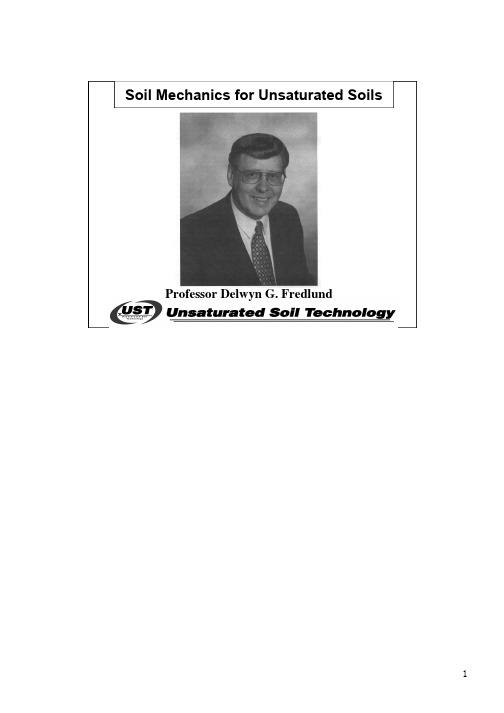
Soil Mechanics for Unsaturated Soils Professor Delwyn G. Fredlund•The study of a multi-phase system such as an unsaturated soil, requires an understanding of the properties of each component phase.rties of each phase of an unsaturated soil; ii.) an understanding of the interaction between air and water; iii.) establishment of useful volume-mass relations for solving engineering problems.Additional notes:Soil particles &contractile skinbehave as solidsAir & waterbehave as fluids•An unsaturated soil is commonly referred to as a 3-phase system composed of: i.) solids (soil particles); ii.) water; iii.) iii.) air.•The air-water interface (i.e., the contractile skin) warrants inclusion as an additional phase due to its unique and specific properties.•The contractile skin interacts with the soil particles in an independent manner and can significantly change the mechanical behavior of an unsaturated soil.fore can be neglected in volume-mass relationships.•The air phase might be present in an unsaturated soil either in a continuous or an occluded (bubbles) form.Additional notes:Required tounderstandthe stress stateanalysisSufficient forMapping phasechanges•Gravimetric and volumetric relationships for unsaturated soil are based on various mass and volume ratios of the component phases.•A rigorous microscopic analysis of the volume-mass properties of an unsaturated soil mass requires the inclusion of the contractile skin.•Using a macroscopic (phenomenological) approach, an unsaturated soil can be considered as a three-phase continuum system.•The most important property of the contractile skin is its ability to exert a tensile pull which is a consequence of the surface tension generated between the two pore-fluid phases (i.e., air and water).Additional notes:•Air is a mixture of several gases and varying amounts of water vapor. water vapor is present.•Air is compressible and its density requires additional considerations in terms of pressure and temperature.Additional notes:Air is a mixture of several gases that act in an independent manner•Air is considered to behave as an “ideal gas” under pressures and temperatures commonly encountered in geotechnical engineering. •The molecular mass of air , ωa , depends on the mixture of dry air and water vapor.lar mass ofwater vapor is 18.016 kg/kmol.from0.000002% to 5% (Harrison, 1965). Additional notes :Density is equal to mass per unit volume Density of air is directlyproportional to the absolute air pressure•Amounts of Nitrogen (N 2) and Oxygen (O 2) are essentially constant.•Carbon dioxide (CO 2) content in air may vary depending on the rate of consumption of fossil fuels. Additional notes:•Water is essentially a homogeneous substance the world over, except for variations due to salts and isotopes of hydrogen and oxygen (Dorsey, 1940).•Distilled water under the pressure of its saturated vapor is called pure, saturated water.•The density of water must be measured experimentally.•Variations in the density of water due to temperature differences are more significant than variations due to applied pressure.Additional notes:SURFACE TENSION •A molecule in the interior of the water experiences equal forces in all directions whilea water molecule in the contractile skin experiences an unbalanced force towards the interior of the water.actile skin.alled its surface tension,T s (i.e., units of N/m 2).•Contractile skin behaves like an elastic membrane.-water surface can be related to surface tensionand the radius of curvature by considering equilibrium.Additional notes:Surface Tension Phenomena•Surface tension is measured as the tensile force per unit length along the contractile skin (i.e., units of N/m).•Surface tension is tangential to the contractile skin surface. Its magnitude decreases as temperatures decreases.u a , that is greater than thewater pressure, u w .•The pressure difference, (u a -u w ) is referred to as matric suction.Additional notes:•Contractile skin forms a warped or saddle-shaped surface (i.e., 3-D membrane) that has different curvatures along two orthogonal (i.e., R 1and R 2for example).o C.-water interface.Additional notes:State Diagram for Water(from van Haveren and Brown, 1972) •Water phase can exist in one of three states: i.) solid state as ice; ii.) liquid state aswater; iii.) gaseous state as water vapor.•The vaporization curve is also called the vapor pressure curve of water.•The fusion curve separates the solid and liquid states.•The sublimation curve separates the solid and vapor states.•Triple point of water is achieved at a temperature of 0o C and a pressure of 0.61 kPa.Additional notes:•The vaporization curve represents an equilibrium condition between the liquid and vapor states of water.•At equilibrium, evaporation and condensation processes occur simultaneously at the same rate.•Rate of condensation depends on the water vapor pressure it reaches at itssaturation value on the vaporization value.•Evaporation rate depends only on temperature.•Water vapor is mixed with air in the atmosphere, and has no effect on thebehavior of the water vapor.•Water vapor may not be in equilibrium with adjacent water. Water vapor in air can be under-saturated, saturated or super-saturated depending on the partialpressure of water vapor.•The degree of saturation with respect to water vapor is referred to as relative humidity, RH.Additional notes:•Water molecules form a lattice structure with openings referred to as a “cage” that can be occupied by gas.•Air dissolves water and fills the “cages” which comprise approximately 2% by total volume.Additional notes:•The volumetric coefficient of solubility, h,varies slightly with temperature.•The rate at which mass is transferred across a unit area is equal to the product of the coefficient of diffusion, D,and the concentration gradient.•In the diffusion of air through water, the concentration difference is equal to the difference in density between the free air and the dissolved air in the water.•The pressure difference between the free air and the air dissolved in the water becomes the driving potential for the free air to diffuse into the water.•The coefficient of diffusion for air through the pore-water in a soil appears to differ by several orders of magnitude from that for air through free water.Additional notes:•Volume of air dissolved in water is essentially independent of air or water pressures.•Absolute pressure of the dissolved air is equal to the absolute pressure of the free air under equilibrium conditions.•Volume of air dissolved in water is constant for different pressures.•Ratio between the mass of each gas that can be dissolved in a liquid and the mass of the liquid is called the Coefficient of Solubility , H.•Coefficients of Solubility are referenced to a standard pressure of 101.3 kPa.•Ratio of the volume of dissolved gas, V d ,in a liquid to the volume of the liquid is the Volumetric Coefficient of Solubility , h.Additional notes :•A cylinder with a piston and porous stone analogy is useful in visualizing and analyzing the behavior of air-water mixtures.•The “porous stone” has pores equaling 2% of its volume. The “porto simulate the behavior of water.•An initial pressure is applied equally to the free air and the “•An imaginary valve is placed at the boundary between the free air and the “porous stone”.•When the piston is loaded, it compresses the free air above theporous stone inaccordance with Henry’s law.•Henry’s law states that the mass of gas dissolved in a fixed quantity of liquid, at constant temperature, is directly proportional to the absolute pressure of the gas above the solution (Sisler et al., 1953).•After several increases of the applied loading, all free air will have moved into the “porous stone”, and any additional applied load will be carriedAdditional notes:•The water lattice is relatively rigid and stable (Dorsey, 1940) and the density of water changes little as a consequence of the presence of the dissolved air.•Dissolved air has no measurable effect to the density of water at a temperature of about 22o C.Additional notes:•An unsaturated soil has air and water pressures at different magnitudes.•The mass of air going into or coming out of the water is time dependent.•The amount of gas dissolved in water is referred to as its Solubility .•The rate of solution of a gas is referred to as its Diffusivity .Additional notes:•The volume-mass relations of the soil particles, water, and air phases are useful properties in engineering practice, particularly for an unsaturated soil.•Both mechanical and hydraulic behaviors of an unsaturated soil mass are highly dependent on the relative proportion of the three component phases (i.e., solid, water and air).•Soil properties such as degree of saturation, porosity and void ratio express volumetric proportions involving the three phases of an unsaturated soil mass.•The above volumetric properties associated with the density of each phase allows the definition of all the index properties commonly utilized in engineering practice to characterize the state of a soil mass.Additional notes:•Each phase of an unsaturated can be expresses as a percentage of the totalvolume by using the definition of porosity.•The volume of the contractile skin can be assumed to be negligible.•The porosity with respect to the water phase, n w ,is equivalent to the volumetric water content, θw .•A soil mass might change its total volume in response to changes in the stress state applied. However, the volume of solid particles is constant.•Void ratio of a soil mass expresses the ratio of the void volume to the volume of the solid particles.Additional notes:•The degree of saturation expresses the percentage of void space filled by the liquid phase (i.e., water).dry (i.e., S = 0%),saturated (i.e., S = 100%) or unsaturated ( 0% < S < 100%).•The transition zone between a continuous air phase and occluded air bubbles occurs when the degree of saturation is between approximately 80-90%.•The water content can also be measured either in a gravimetric manner (i.e., ratio of water to solids mass) or in a volumetric manner (i.e., ratio of water volume to total volume).Additional notes:•Two commonly used soil density definitions are the total density and the dry density. Total density is called the bulk density.•Dry density of a soil mass is dependent upon the mineralogy of the solidphase, in terms of specific gravity,G s , and the porosity of the soil structure.•The saturated density of the soil is the total density of the soil for the casewhere the voids are filled with water (i.e., S = 100%).•The buoyant density of a soil is the difference between the saturated density of the soil and the density of water.•A “basic volume-mass relationship” for a soil mass can be derived by using the idealized diagram where each soil phase is defined by its volume and its mass.Additional notes:•Volume-mass relationships in engineering practice neglect the mass of airphase, but consider the volume of the air phase.•The expression (Se = wG s )is the basic volume-mass relationshipcommonly used in engineering practice and it represents the continuityequation for a soil mass.•Additional notes:•Density, ρis the ratio of mass to volume. Each soil phase has its own density.•Specific gravity of the soil particles, Gs ,is defined as the dimensionless ratio between thedensity of the soil particles and the density of water at a temperature of 4o C underatmospheric pressure conditions (i..e, 101.3 kPa).•Density of water at 4o C and at 101.3 kPa is 1000 kg/m 3.•Specific volume, v o ,is the inverse of density (i.e., ratio of volume to mass).•Unit weight, γis the product of density, ρ, and gravitational acceleration, g,(i.e., 9.81 m/s 2).Additional notes:•In engineering practice, the total density is often increased by imposing a reduction in the void volume of a soil mass.•Volume of pore-water in a soil mass is highly dependent uponenvironmental conditions and therefore is often a variable to be considered.•The dry density is independent of the volume of the pore-water and is often used in semi-empirical relationships for the soil.Additional notes:•The dry density curve corresponding to a degree of saturation of 100 % is called the “zero air voids”, ZAV, curve.•The dry density curves curves for different degrees of saturation should be presented in connection with soil compaction data.•Compaction is a mechanical process used to increase the dry density of soils (i.e., densification).Additional notes:-Start of process:•The basic volume-mass relationship (i.e., Se = w Gs ) applies to anycombination of S, e and w , and therefore it can be used to obtain changes in any of these properties when the other two properties are defined.•The basic volume-mass relationship can therefore be used to deriveequations associating changes of S, e and w .Additional notes:•Soil mixtures can occur in various forms in nature.•Mixture of soil particles and air constitutes a dry soil while a mixture of soil particles and water constitutes a saturated soil.•Unsaturated soils lie between dry and saturated soil conditions and constitute a mixture of soil particles, air and water in differing percentages.•The density of a soil mixture can also be formulated for situations where there is a change in the volume of air due to compression under undrained conditions. •The analogy of the piston-porous stone is a useful tool to derive the formulation of the density of the soil by considering the air compression.•In the above formulation, Boyle’s law is applied to the free and dissolved air under isothermal conditions.Additional notes:•Under isothermal conditions, the ratio of the density to the absolute pressure of the air phase (i.e., free and dissolved air) in a soil mixture is constant.•The final density of water is computed as the ratio of the total mass of water and dissolved air to the total volume of water and dissolved air under final equilibrium conditions.Additional notes:•The conservation of mass is herein applied to a system (i.e., soil mixture) under isothermal conditions, therefore, all the previous equations can be applied. •The total density of the soil mixture is therefore a function of the constant densities and volumes of water and solid phases as well as of the variable density and volume of the air phase.•The total density formulation can be applied to the definition of particular cases where one of the three phases (i.e., solid, water and air) in a soil mixture is not present.Additional notes:•The first equation above is a general mixture equation for density after the soil has been subjected to a change in air pressure.•The volume of dissolved air , V d ,is related to the volume of water, Vw ,by thevolumetric coefficient of solubility, h (i.e., V d = hV w ).•The equation incorporates the effect of air going into solution due to the change in the air pressure.•Where air does not have time to dissolve in water, the volumetric coefficient of solubility, h,might be set to zero.•The air-water mixture always has a density between that of air and water.•The density of an air-water mixture can be obtained from the general equation is obtained by setting the volume of the soil particles, Vs ,to zero, and the initial voidratio, e i ,becomes infinity.Additional notes:。
非饱和土的力学理论
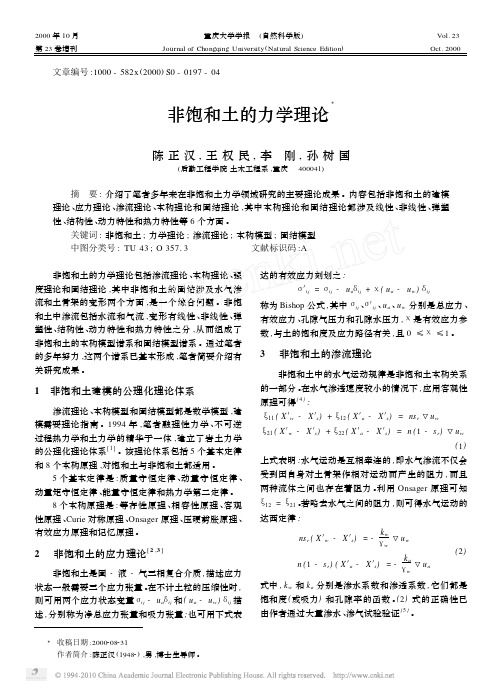
文章编号:1000-582x(2000)S0-0197-04非饱和土的力学理论Ξ陈正汉,王权民,李 刚,孙树国(后勤工程学院土木工程系,重庆 400041) 摘 要:介绍了笔者多年来在非饱和土力学领域研究的主要理论成果。
内容包括非饱和土的建模理论、应力理论、渗流理论、本构理论和固结理论,其中本构理论和固结理论都涉及线性、非线性、弹塑性、结构性、动力特性和热力特性等6个方面。
关键词:非饱和土;力学理论;渗流理论;本构模型;固结模型 中图分类号:TU43;O357.3 文献标识码:A 非饱和土的力学理论包括渗流理论、本构理论、强度理论和固结理论,其中非饱和土的固结涉及水气渗流和土骨架的变形两个方面,是一个综合问题。
非饱和土中渗流包括水流和气流,变形有线性、非线性、弹塑性、结构性、动力特性和热力特性之分,从而组成了非饱和土的本构模型谱系和固结模型谱系。
通过笔者的多年努力,这两个谱系已基本形成,笔者简要介绍有关研究成果。
1 非饱和土建模的公理化理论体系渗流理论、本构模型和固结模型都是数学模型,建模需要理论指南。
1994年,笔者融理性力学、不可逆过程热力学和土力学的精华于一体,建立了岩土力学的公理化理论体系[1]。
该理论体系包括5个基本定律和8个本构原理,对饱和土与非饱和土都适用。
5个基本定律是:质量守恒定律、动量守恒定律、动量矩守恒定律、能量守恒定律和热力学第二定律。
8个本构原理是:等存性原理、相容性原理、客观性原理、Curie对称原理、Onsager原理、压硬剪胀原理、有效应力原理和记忆原理。
2 非饱和土的应力理论[2,3]非饱和土是固-液-气三相复合介质,描述应力状态一般需要三个应力张量。
在不计土粒的压缩性时,则可用两个应力状态变量σij-u aδij和(u a-u w)δij描述,分别称为净总应力张量和吸力张量;也可用下式表达的有效应力刻划之:σ′ij=σij-u aδij+χ(u a-u w)δij称为Bishop公式,其中σij、σ′ij、u a、u w分别是总应力、有效应力、孔隙气压力和孔隙水压力,χ是有效应力参数,与土的饱和度及应力路径有关,且0≤χ≤1。
非饱和土力学-第二节非饱和土的水力特性
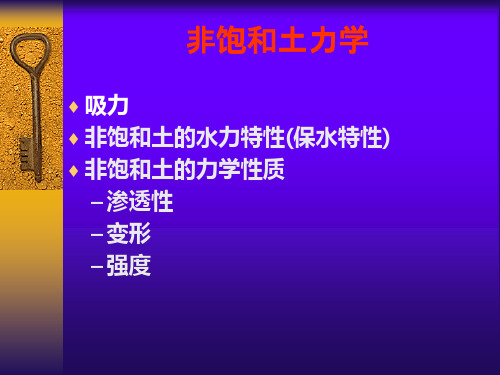
土结构对水分特征曲线的影响
Degree of satuartion (%)
100 80 60 40 20 0 0 10 101 102
e0=1.10 Compacted
e0=1.15 Pre-consolidated
Suction (kPa)
103
104
同一种土,即使孔隙比e相近,其SWCC也会因土结构的不同而不同。 用不同制样方法得到同种土试样的SWCC。在e相近的条件下,用泥 浆固结样的SWCC在击实试样的右边,i.e.,泥浆样的进气值要大。 泥浆样的过渡区间的曲线斜率比击实样的要陡。其原因可能是由于 泥浆样的孔隙比较均匀,大孔隙尺寸比击实样的要小
土的粘性越大,同一含水量时 吸力越大。这是由于土的颗粒 大小及土的矿物成分不同所引 起的,颗粒越细,矿物的亲水 性越强,它们的吸力就越大
Zones of Desaturation Defined by a SoilWater Characteristic Curve, SWCC
Gravimetric water content, w (%)
Unsaturated Soil REV as a Four Phase System
REV = Representative Elemental Volume
Air
Contractile skin Soil particles
-Two PLeabharlann ases that deform and come to rest under a stress gradient (SOLIDS) -Soil structure
孔隙比对水分特征曲线的影响
100
Sr(%)
90 80 70 60 50 0.1
《非饱和土有效应力》课件

非饱和土的特点
特点一
非饱和土的应力-应变关系受到含水率的影响,含水率的变化会导 致土的力学性质发生变化。
特点二
非饱和土的抗剪强度和压缩性随含水率的变化而变化,含水率越高 ,抗剪强度越低,压缩性越大。
特点三
非饱和土的渗透性和导热性也受到含水率的影响,含水率越高,渗 透性越低,导热性越差。
02
非饱和土的有效应力原理
有效应力的基本概念
有效应力
指土壤骨架承受的应力,是土壤保持稳定的因 素。
有效应力原理
土壤的变形和强度与有效应力相关,而非总应 力。
有效应力与孔隙压力
孔隙压力的变化会影响有效应力的变化。
有效应力原理在非饱和土中的应用
非饱和土的特性
01
非饱和土中存在吸力和孔隙压力,它们对土壤的力学性质有显
著影响。
有效应力在非饱和土中的表现
有效应力在地下水控制中的应用
总结词:关键作用
VS
详细描述:在地下水控制中,非饱和 土的有效应力对土壤水分的运移和地 下水的流向有着重要影响。通过研究 有效应力,可以更好地了解地下水运 动规律,为地下水资源的合理开发和 利用提供依据。
有效应力在地下水控制中的应用
总结词:工程实践
详细描述:在地下水控制实践中,有效应力分析可以帮助确 定地下水水位、流向和流速等参数。同时,根据有效应力的 大小和分布,可以制定合理的地下水开采方案和防止地面沉 降的措施。
将渗透性转化为有效应力。
04
非饱和土的有效应力与工程实 践
有效应力在边坡稳定性分析中的应用
总结词:重要应用
详细描述:在边坡稳定性分析中,非饱和土的有效应力是一个关键因素。通过考 虑有效应力,可以更准确地评估边坡在不同降雨条件下的稳定性,从而采取适当 的加固措施。
非饱和土力学

非饱和土力学
非饱和土力学是研究非饱和土的力学性质和行为的学科。
非饱和土是指土壤中含有水分但不是完全饱和状态的土壤。
在非饱和状态下,土壤的力学性质和行为与饱和状态下有很大的不同。
非饱和土力学主要研究以下几个方面:1.非饱和土的吸力特性:非饱和土中的水分存在于土颗粒之间的微小孔隙中,这些孔隙中的水分会受到吸力的作用。
吸力是非饱和土力学中的一个重要参数,它对土壤的力学性质和行为有很大的影响。
2.非饱和土的渗透特性:非饱和土的渗透特性与饱和状态下有很大的不同。
在非饱和状态下,土壤中的水分会受到吸力的作用,因此渗透速度会比饱和状态下慢很多。
3.非饱和土的力学性质:非饱和土的力学性质与饱和状态下也有很大的不同。
在非饱和状态下,土壤中的水分会受到吸力的作用,因此土壤的强度和变形特性会受到吸力的影响。
4.非饱和土的稳定性:非饱和土的稳定性也是非饱和土力学研究的一个重要方面。
在非饱和状态下,土壤中的水分会受到吸力的作用,因此土壤的稳定性会受到吸力的影响。
总之,非饱和土力学是一个非常重要的学科,它对于土壤工程和地下水工程的设计和施工都有着重要的意义。
非饱和土土力学新PPT课件
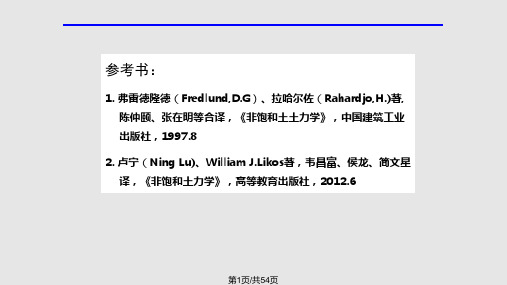
1. 弗雷德隆德(Fredlund,D.G)、拉哈尔佐(Rahardjo,H.)著, 陈仲颐、张在明等合译,《非饱和土土力学》,中国建筑工业 出版社,1997.8
2. 卢宁(Ning Lu)、William J.Likos著,韦昌富、侯龙、简文星 译,《非饱和土力学》,高等教育出版社,2012.6
第30页/共54页
非饱和土土力学理论
4、非饱和土的应力应变关系及本构模型
(3)弹塑性模型(Sheng Daichao)
非饱和土应力应变关系
前期固结压力 残余吸力
第31页/共54页
非饱和土土力学理论
4、非饱和土的应力应变关系及本构模型
(3)弹塑性模型(Sheng Daichao)
屈服面方程
接近饱和时吸力 饱和时屈服压力 参考压力
f
(
uw) tan' C0 tan'
第22页/共54页
非饱和土土力学理论
3、非饱和土的强度理论
(4) 直接用含水量表示的抗剪强度公式
缪林昌结合Bishop公式和Fredlund公式,直接用含水量或饱和度来表示非饱和土的强度:
f cw tanw
lg c a1 b1w
lg a2 b2w
f c tan A110B1w tan(A210B2w)
Se
Se
A11
B1
0
Gs
B2
t an(A210
Gs
)
第23页/共54页
非饱和土土力学理论
3、非饱和土的强度理论
(5)陈正汉等认为,土的强度随温度和吸力的升高而增大,重塑黄土的凝聚力随 吸力增加而提高,内摩擦角则基本不变,据此建立了土的广义抗剪强度公式:
非饱和土力学
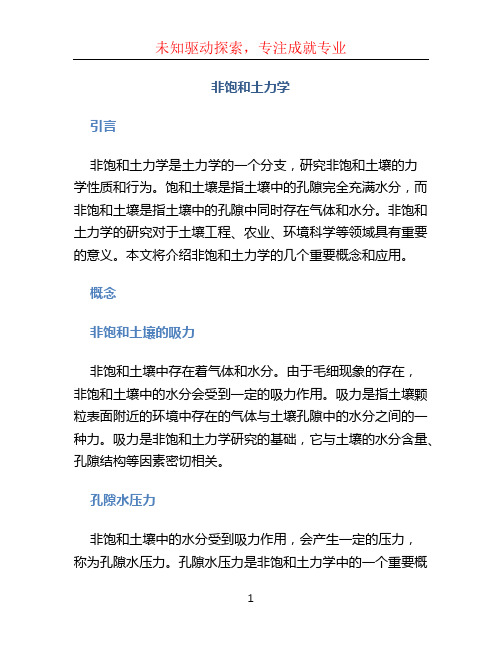
非饱和土力学引言非饱和土力学是土力学的一个分支,研究非饱和土壤的力学性质和行为。
饱和土壤是指土壤中的孔隙完全充满水分,而非饱和土壤是指土壤中的孔隙中同时存在气体和水分。
非饱和土力学的研究对于土壤工程、农业、环境科学等领域具有重要的意义。
本文将介绍非饱和土力学的几个重要概念和应用。
概念非饱和土壤的吸力非饱和土壤中存在着气体和水分。
由于毛细现象的存在,非饱和土壤中的水分会受到一定的吸力作用。
吸力是指土壤颗粒表面附近的环境中存在的气体与土壤孔隙中的水分之间的一种力。
吸力是非饱和土力学研究的基础,它与土壤的水分含量、孔隙结构等因素密切相关。
孔隙水压力非饱和土壤中的水分受到吸力作用,会产生一定的压力,称为孔隙水压力。
孔隙水压力是非饱和土力学中的一个重要概念,它描述了土壤中水分的分布和移动情况。
孔隙水压力的变化会影响非饱和土壤的力学性质和行为。
非饱和土壤的力学性质非饱和土力学研究的一个重要目标是揭示非饱和土壤的力学性质。
非饱和土壤的力学性质与饱和土壤有一些明显的差异。
例如,非饱和土壤的抗剪强度和变形特性会受到吸力和孔隙水压力的影响。
非饱和土壤的力学性质的研究对于土壤工程的设计和施工具有重要的指导意义。
应用土壤含水量测定非饱和土力学的研究需要准确测定土壤中的水分含量。
常用的方法有重量法、电容法、压力传感器法等。
这些方法可以测定不同吸力下土壤中的水分含量,从而揭示土壤的吸力特性和水分传输规律。
非饱和土壤的稳定性分析非饱和土壤的力学性质和行为与饱和土壤存在一定的差异。
因此,非饱和土壤的稳定性分析需要考虑吸力和孔隙水压力等因素对土壤的影响。
非饱和土壤的稳定性分析可以用于土壤边坡、挡土墙、基础等工程的设计和施工。
土壤水分调控非饱和土力学的研究成果可以应用于农业、环境科学等领域。
例如,在农业生产中,了解土壤中的水分分布和移动规律,可以合理调控土壤水分,提高植物的生长和产量。
此外,在环境科学研究中,非饱和土力学的研究成果可以用于土壤污染防治和土壤水源涵养等方面。
非饱和土理论的分析研究
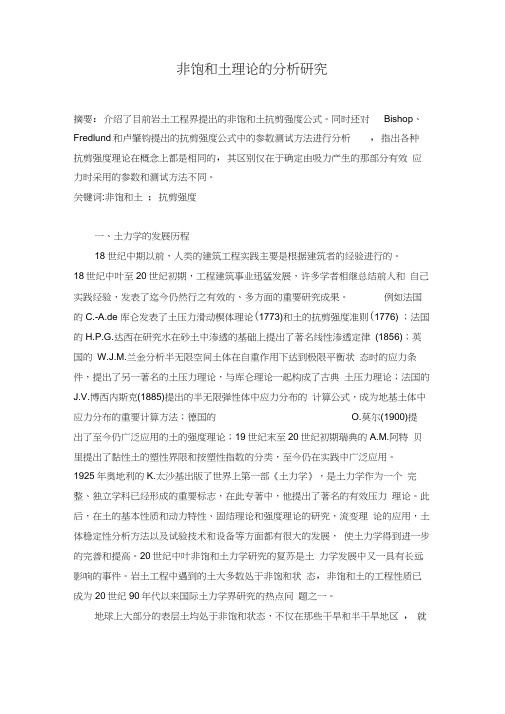
非饱和土理论的分析研究摘要:介绍了目前岩土工程界提出的非饱和土抗剪强度公式。
同时还对Bishop、Fredlund和卢肇钧提出的抗剪强度公式中的参数测试方法进行分析,指出各种抗剪强度理论在概念上都是相同的,其区别仅在于确定由吸力产生的那部分有效应力时采用的参数和测试方法不同。
关键词:非饱和土;抗剪强度一、土力学的发展历程18世纪中期以前,人类的建筑工程实践主要是根据建筑者的经验进行的。
18世纪中叶至20世纪初期,工程建筑事业迅猛发展,许多学者相继总结前人和自己实践经验,发表了迄今仍然行之有效的、多方面的重要研究成果。
例如法国的C.-A.de 库仑发表了土压力滑动楔体理论(1773)和土的抗剪强度准则(1776) ;法国的H.P.G.达西在研究水在砂土中渗透的基础上提出了著名线性渗透定律(1856);英国的W.J.M.兰金分析半无限空间土体在自重作用下达到极限平衡状态时的应力条件,提出了另一著名的土压力理论,与库仑理论一起构成了古典土压力理论;法国的J.V.博西内斯克(1885)提出的半无限弹性体中应力分布的计算公式,成为地基土体中应力分布的重要计算方法;德国的O.莫尔(1900)提出了至今仍广泛应用的土的强度理论;19世纪末至20世纪初期瑞典的A.M.阿特贝里提出了黏性土的塑性界限和按塑性指数的分类,至今仍在实践中广泛应用。
1925年奥地利的K.太沙基出版了世界上第一部《土力学》,是土力学作为一个完整、独立学科已经形成的重要标志,在此专著中,他提出了著名的有效压力理论。
此后,在土的基本性质和动力特性、固结理论和强度理论的研究,流变理论的应用,土体稳定性分析方法以及试验技术和设备等方面都有很大的发展,使土力学得到进一步的完善和提高。
20世纪中叶非饱和土力学研究的复苏是土力学发展中又一具有长远影响的事件。
岩土工程中遇到的土大多数处于非饱和状态,非饱和土的工程性质已成为20世纪90年代以来国际土力学界研究的热点问题之一。
非饱和土土力学(新)

温度
3 ua 200kPa
u a u w 100 kPa
15℃ 30℃ 45℃ 60℃
温度的影响
非饱和土土力学理论
4、非饱和土的应力应变关系及本构模型
(1)弹性模型
Fredlund和Morganstern(1976)、Fredlund(1979)提出了基于双应力变量 ( u a ) 和 (ua u w ) 的弹性应力应变关系:
强度分析:
固结变形分析:
传统(经典)土力学的局限
3、现有土工试验仪器主要是针对饱和土设计的
① 试验数据按饱和土相关理论来整理,不符合实际情况 。 ② 不能测负孔隙水压力。 ③ 未考虑气相影响。
单轴压缩
三轴压缩
非饱和土土力学理论
非饱和土物质组成:固体、气体和液体
固体
液体
气体
n
Vpores Vtotal
固结本构方程
Mechanical constitutive law
q w k grad( pw w z)
d v m dp
1 dp K
pw 1 p k 2 pw wm t 3 t
3-D consolidation
传统(经典)土力学的局限
2、固结变形和强度分析中有效应力的表现形式是不一致的
Vliquid Vgas Vtotal
Sl
Vliquid Vpores
Vliquid Vliquid Vgas
饱和度
1 Sg
空隙度
非饱和土土力学理论
非饱和土为固、液、气相及收缩膜组成的四相介质
非饱和土土力学理论
存在一个新的应力状态变量:吸力
非饱和土力学 pdf
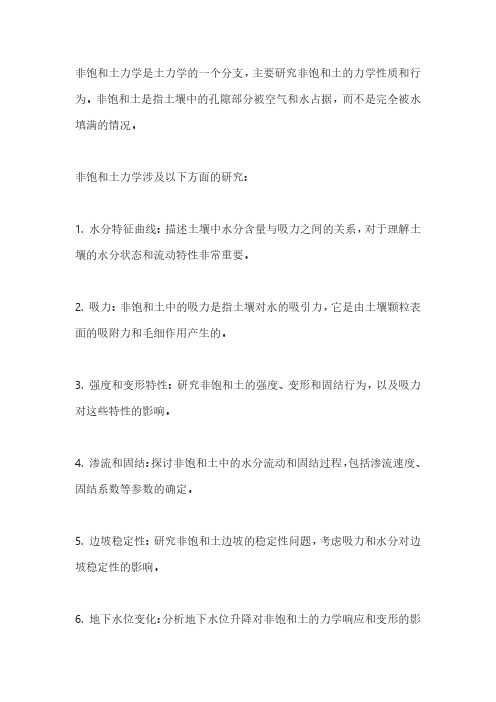
非饱和土力学是土力学的一个分支,主要研究非饱和土的力学性质和行为。
非饱和土是指土壤中的孔隙部分被空气和水占据,而不是完全被水填满的情况。
非饱和土力学涉及以下方面的研究:
1.水分特征曲线:描述土壤中水分含量与吸力之间的关系,对于理解土壤的水分状态和流动特性非常重要。
2.吸力:非饱和土中的吸力是指土壤对水的吸引力,它是由土壤颗粒表面的吸附力和毛细作用产生的。
3.强度和变形特性:研究非饱和土的强度、变形和固结行为,以及吸力对这些特性的影响。
4.渗流和固结:探讨非饱和土中的水分流动和固结过程,包括渗流速度、固结系数等参数的确定。
5.边坡稳定性:研究非饱和土边坡的稳定性问题,考虑吸力和水分对边坡稳定性的影响。
6.地下水位变化:分析地下水位升降对非饱和土的力学响应和变形的影
响。
7.数值模拟和实验技术:开发用于研究非饱和土力学问题的数值模型和实验方法。
非饱和土力学在土木工程、地质工程、环境工程等领域具有重要应用,例如地基基础设计、边坡稳定性分析、地下水资源管理和环境修复等。
深入研究非饱和土力学对于确保工程的安全性和可持续性至关重要。
毛细作用于吸力(非饱和土力学)

第一节 毛细管作用和吸力
饱和土力学讨论了地下水位以下水的 流动, 土的变形和强度。 非饱和土力学研究从地表面到地下 水面之间土的性质。 这部分土的孔隙中,通常同时存在 着水和空气,呈非饱和状态。可以认 为,这部分土中的水来源于地表面雨 水等的渗透和由于毛细管的作用地下 水对它的补给
照片是用圆铝棒堆积层模拟土的二维模 型,在圆铝棒堆积层中加水,粒子间的孔 隙中有水吸附。从相片中可以观察到,粒 子接点处积聚着水,形成了弯液面
hc C /(ed10 )
C是由土颗粒的粒径和表面粗糙程度等因素决定的系数, C在0.1~0.5cm2的范围内变化。根据上式可以推算出土 中毛细管上升高度hc的大致值。如果假设粘土地基的 d10≈1μm=10-4cm、e≈1,C=0.05cm2时,可得hc=5m
大气压力pa与弯液面下面的水压力uw及表面张力T 的关系。根据力的平衡
陶土板的含水率影响其热扩散速率,陶土板干燥时,热扩散慢,
陶土板潮湿时,散热快。利用这一特性,用测热扩散速率的方法 推算陶土板含水率。给陶土板中心部位加一定的热量,如果含水 率高,热量较快扩散开来,几秒钟(如 30s)后,温度传感器测 得的温度就较低;反之,如果含水率低,热量扩散较慢,几秒钟 (如 30s)后,温度传感器测得的温度就较高。如此可建立含水 率与温度的关系。根据测得的温度,知含水率,进而可得吸力。 可用于室内试验,也可用于现场量测。现场量测时,可在钻孔中 插入这样的吸力探头,也可埋在土中的不同深度处,作长期自动 量测,有较广泛的用途。
F (ua uw ) a T (2a )
2
F可表示成ua-uw和表面张力T的函数,所以粒子 间的结合力F与水的表面张力、粒径和附着于 粒子接触点附近的水量等因素有关
非饱和土力学讲义(Fredlund在香港科大)chapter5ustmod
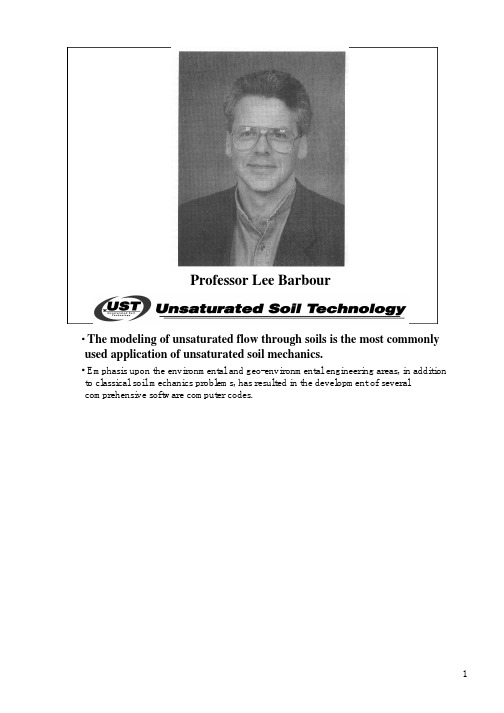
Professor Lee Barbour•The modeling of unsaturated flow through soils is the most commonly used application of unsaturated soil mechanics.•Emphasis upon the environmental and geo-environmental engineering areas, in addition to classical soil mechanics problems, has resulted in the development of severalcomprehensive software computer codes.•This chapter deals with the flow of the fluid phases (i.e., air and water) through an unsaturated soil.•The analysis of fluid flow through an unsaturated soil requires the definition of the driving potential and a flow law associated to each fluid phase.•The diffusion of air through water is also discussed as a phenomenon associated to unsaturated soils.Additional notes:•The analysis of fluid flow requires a law to relate the flow rate to the driving potential through the use of appropriate coefficients.•Air in an unsaturated soil can occur either in an occluded form or a continuous form depending upon the degree of saturation of the soil.•A knowledge of the driving potentials that causes air and water to flow through an unsaturated soil is necessary for solving geotechnical engineering problems.•The movement of air through the water phase is referred to as air diffusion and its driving potential needs to be defined.•Water flow is caused by a hydraulic head gradient, where the hydraulic head consists of an elevation head plus a pressure head.•The flow of air in the continuous phase form is governed by a concentration or pressure gradient. The elevation gradient has a negligible effect.Additional notes:•What is the driving potential for the flow of water through an unsaturated soil?•Several concepts, such as water content gradient, pressure head gradient, soil suction gradients, and hydraulic head gradient have been used to explain the flow of water through an unsaturated soil.•The above figure illustrates some hypothetical cases which demonstrate that matric suction gradient is not the driving potential that causes water to flow through an unsaturated soil.•Case 1 illustrates that water can flow through an unsaturated soil from a region of low matric suction to another region at a relatively high matric suction.•Case 2 illustrates that the flow of water through an unsaturated soil can occur between regions with equal matric suctions.•Case 3 illustrates that water can flow through an unsaturated soil even when the left-hand side (i.e., departing region) is at a matric suction higher than the right-hand side (i.e., target region).•Water flow can be defined most appropriately in terms of a hydraulic head gradient. •The special case where the air pressure is zero, which is the common situation in nature, the matric suction gradient is numerically equal to the pressure gradient in the water.•The elevation head can be omitted then the matric suction gradient is equal to the hydraulic head gradient and all points in the soil mass are at the same elevation (i.e., horizontal flow).Additional notes:No suctiongradient•A point (e.g., an elemental volume) in the water phase has three primary components of energy; namely, gravitational, pressure, and velocity.•Point A has a gravitational potential energy, Eg , which is a function of the water element mass and the distance, y , relative to a datum.•When the water density, ρw , is constant, the pressure energy can be expressed as a function of the pore-water pressure, the water volume, and the water density at point A .•The flow rate of water at point A gives rise to a velocity energy that can be expressed as a function of the mass of water and the velocity of water at point A .•The total energy (i.e., mechanical energy) at point A is the summation of thegravitational, pressure, and velocity components.•Potential or hydraulic head is defined as energy per unit of weight. Therefore, the hydraulic head consists of three components; namely, the gravitational head, the pressure head and the velocity head.•The velocity head in a soil is commonly negligible in comparison to the gravitational and the pressure heads.Additional notes:•The heads used in the definition of hydraulic potential have the dimensions of length. •Hydraulic head is a measurable quantity, the gradient of which causes flow in saturated and unsaturated soils.•Piezometers and tensiometers can be used to measure the in situ pore-water pressure at any point in a soil mass.•A piezometer can be used to measure positive pore-water pressures at a point in a soil mass.•A tensiometer can be used to measure negative pore-water pressures at a point in a soil mass.•In the above figure, point A has a higher total head than point B [i.e., hw (A) > h w (B)] and therefore water will flow from point A to point B due to the hydraulic head gradient.•The driving potential causing flow in the water phase through a soil mass has the same form for both saturated (i.e., point B ) and unsaturated (i.e., point A ) soils (Freeze & Cherry, 1979).Additional notes:•Darcy’s law describes the flow of water through an unsaturated soil. However, the coefficient of permeability in an unsaturated soil need not be a constant.•The coefficient of permeability in an unsaturated soil is a variable that is predominantly a function of the water content or the matric suction in the unsaturated soil.•Water can be visualized as flowing only through the pore space filled with water. The air filled pore spaces are nonconductive channels to the flow of water.•To verify Darcy’s law for unsaturated soils, experiments were conducted using acolumn of unsaturated soil, with a uniform water content and a constant water pressure head subjected to various gradients of gravitational heads.•The results indicated that at a specific water content, the coefficient of permeability, k w , is constant for various hydraulic head gradients applied to the unsaturated soil.•The rate of water flow through an unsaturated soil is linearly proportional to the hydraulic head gradient, with the coefficient of permeability being a constant, similar to the situation for a saturated soil.•Therefore, Darcy’s law can also be applied to unsaturated soils.However, themagnitude of the coefficient of permeability is a function of volumetric water content, θw .Additional notes:•The coefficient of permeability depends upon the properties of the fluid and the properties of the porous medium. Different types of fluids (e.g., water and oil) ordifferent types of soil (e.g., sand and clay) produce different values for the coefficient of permeability, k w .•The intrinsic permeability of a soil, K , represents the characteristics of the porous medium and is independent of the fluid properties.•In geotechnical engineering, the term coefficient of permeability, kw , is a commonly used term.•In an unsaturated soil, the coefficient of permeability, k w , is affected by changes in void ratio and more significantly by the degree of saturation (or water content).•As a soil becomes unsaturated, air first replaces some of the water in the large pores, and this causes water to flow through the smaller pores, with an increased tortuosity to the flow path.•Additional increases in matric suction leads to further decreases in the the pore volume occupied by water, and the air-water interface is drawn closer and closer to the soil particles.•As a result, the coefficient of permeability with respect to the water phase decreases rapidly as the space available for water flow reduces.Additional notes:•Change in void ratio in an unsaturated soil may be small. However, the effect of a change in degree of saturation may be highly significant.•As a result, the coefficient of permeability is often described as a singular function of the degree of saturation, S,or the volumetric water content, θw.•A change in matric suction can produce a more significant change in the degree of saturation than can be produced by a change in net normal stress.•Degree of saturation has been commonly described as a function of matric suction. •Numerous semi-empirical equations for the coefficient of permeability have been derived using the matric suction versus versus degree of saturation curve.•In these equations, the pore-size distribution forms the basis for predicting the coefficient of permeability.•The residual degree of saturation,Sr , is defined as the degree of saturation at whichan increase in matric suction does not produce a significant change in the degree of saturation.Additional notes:•The matric suction versus degree of saturation curve exhibits hysteresis and thedrainage curve is most commonly used. In addition, the soil structure is assumed to be incompressible.•The air entry value of the soil, (u a -u w )b , residual degree of saturation, S r , and the pore size distribution index, λ, are three parameters commonly used when deriving equations for predicting the coefficient of permeability, k w .•Using the concept of effective degree of saturation, S e , the above figure illustrates a procedure for determining the air entry value, the residual degree of saturation, and the pore size distribution index.•The effective degree of saturation can be computed by first estimating the residual degree of saturation.•Plotting the effective degree of saturation versus matric suction and adjusting a horizontal and a sloping line to the calculated data permit the use of a new assumed residual degree of saturation.•The procedure is repeated until all points on the sloping line constitute a straight line. The pore size distribution index, λ,is defined as the negative slope of the effective degree of saturation, S e , versus the matric suction, (u a -u w ), curve.•The intersection point between the straight sloping line and the saturation ordinate (i.e., S e = 1.0) defines the air entry value of the soil.Additional notes:•The above figure shows an equation for effective degree of saturation as a function of the matric suction for values of matric suction greater than the air entry value of the soil.•The figure also illustrates typical matric suction versus degree of saturation curves for various soils.Additional notes:•The above figure illustrates typical λvalues for various soils that have been obtained from matric suction versus degree of saturation curves.•Soils with a wide range of pore sizes have a small value for λ. The more uniform the distribution of pore sizes in a soil, the larger the value for λ.Additional notes:•Brooks and Corey (1964) proposed an equation for the coefficient of permeability, k w , by using the matric suction versus the degree of saturation curve and the concepts of effective degree of saturation and pore-size distribution index , λ.•The coefficient of permeability, kw , for a sandstone is expressed in terms of the relative permeability as compared to the coefficient of permeability of the soil at saturated conditions, k s .•The figure also presents the air permeability of the soil to illustrate its decreasing value as the soil approaches a degree of saturation equal to 100%.Additional notes:•The above table presents several empirical constant, δvalues (i.e., Brooks and Corey, 1964 parameter) and their corresponding pore size distribution indices,λ, for various soil types.(Note that δ= (2+3λ) / λ)•The above values can be used in practice as a first estimation for different soils.Additional notes:•The above figure presents the equation proposed by Gardner (1958) for predicting the coefficient of permeability for an unsaturated soil as function of matric suction.•The equation provides as flexible permeability function that is defined by two constants (a and n ) where “a”is related to the breaking point (i.e., air entry value) and “n ” is defined by the slope of the function.•Four typical functions, with differing values of “a”and “n”illustrates the forms produced by Gardner’s (1958) equation.Additional notes:Gardner’s equation(1958)•The above table summarizes several of the proposed relationships between the coefficient of permeability and matric suction.•The equations illustrate the relationship between coefficient of permeability and matric suction by using soil constants that can be evaluated from the matric suction versus degree of saturation curves.Additional notes:•A coefficient of permeability function, k w (θw ), was proposed using the configurations of the pore space filled with water (Childs and Collis-George, 1950).•The soil-water characteristic curve can also be presented in terms of volumetric water content, θw , versus the matric suction. Therefore, k w can also be expressed directly as a function of matric suction.•The permeability function, k w (θw ), is derived based on Poiseuille’s equation.•The above permeability function has a similar form to the function presented by Kunze et al., (1968) and is slightly modified to use SI units and matric suction is used in the equation instead of pore-water pressure head.•The calculation of the permeability function, k w (θw ),at a specific volumetric water content involves the summation of the matric suction values that correspond to the volumetric water content at and below the value under consideration, (θw )i .Additional notes:Childs andCollis-George(1950)•The calculation of the permeability function, k w (θw ),at a specific volumetric water content involves the summation of the matric suction values that correspond to the volumetric water content at and below the water content under consideration, (θw )i .•A matching factor, (k s /k sc ), based on the saturated coefficient of permeability is necessary in order to provide a more accurate representation of the unsaturated permeability function.•The shape of the permeability function is determined by the terms inside thesummation sign portion of the equation as obtained from the soil-water characteristic curve.•The magnitude of the permeability function needs to be adjusted with reference to the measured saturated coefficient of permeability, k s , by using the matching factor.•If the saturated coefficient of permeability is measured, the permeability function can be predicted directly from the soil-water characteristic curve because all of the terms in front of the summation sign in the equation can be considered as an adjusting factor.•Therefore, the permeability function, k w (θw ), can be written as shown at the bottom of the slide.Additional notes:Childs andCollis-George(1950)•The soil-water characteristic curve can be visualized as an indication of theconfiguration of water-filled pores in the soil mass.•The coefficient of permeability is obtained by dividing the soil-water characteristic curve into “m” equal intervals along the volumetric water content axis.•The matric suction corresponding to the midpoint of each interval is used to calculate the coefficient of permeability.•This computational procedure for obtaining the permeability function appears to be most successful for sandy soils having a narrow pore size distribution (Nielsen et al., 1972).•The soil-water characteristic curve and the prediction of the permeability function for a fine sand (Lakeland sand) are shown on the next slides.Additional notes:•The soil-water characteristic curve for the Lakeland fine sand is shown above. •The figure shows a low air entry value for the soil specimens tested [i.e., (u a -u w )b around 3 kPa] and an estimated residual degree of saturation around 10 kPa.Additional notes:•A comparison between the permeability function, kw (θw ),computed from theproposed equation and experimental data is shown for a fine sand.•There is a satisfactory match between the measured and calculated values.Additional notes:•The coefficient of permeability, k w , is generally assumed to be uniquely related to the degree of saturation, S , or the volumetric water content, θw .•This assumption is reasonable since water flows through the pore-water phase.•The degree of saturation or volumetric water content shows significant hysteresis when plotted versus matric suction.Additional notes:•The relationships between the water content (i.e., S or θw ) and thecoefficient of permeability appear to exhibit little hysteresis (Nielsen and Biggar, 1961).•The permeability function, k w (or θw ), for coarse-textured soils isapproximately the same for both wetting and drying (Nielsen et al., 1972.)Additional notes:No hysteresis•Since there is hysteresis in the relationship between water content and matricsuction, there is also hysteresis in the relationship between the coefficient ofpermeability and matric suction.•The hysteresis in the relationship between the coefficient of permeability andmatric suction depends upon the distribution of pores in the soil.Additional notes:•Air in an unsaturated soil can be present in two forms; namely, a continuous form or as occluded air bubbles.•Air phase is generally continuous when the degree of saturation is below 85%.•Air phase becomes occluded bubbles as the degree of saturation is higher than 90% and the air flow is reduced to a process of diffusion through the pore-water.•Concentration or pressure gradient can be used as the driving potential for the flow of the continuous air phase through an unsaturated soil.•Fick’s law is often used to describe the diffusion of gases through liquids.•A modified Fick’s law, as shown above, relates the mass rate of flow, Ja , to theconcentration gradient, (dC /dy ), by using the transmission constant for air flow through a soil, D a .•The negative sign in the relationship indicates that air flows in the direction of a decreasing concentration gradient.•The concentration of the air, C , in a soil can be expressed as a function of the air pressure by using the air density which is related to the absolute air pressure in accordance with the gas law.Additional notes:•The modified Fick’s law, as shown above, can be used to express the mass rate of flow, Ja , to the pore-air pressure gradient, (d ua /d y ), by using a modified coefficient oftransmission for air flow through soils,D a *.•It can be observed that D a *is a function of the volume-mass properties of the soil.•This modified form of Fick’s law has been used in geotechnical engineering to describe air flow through soils (Blight, 1971).•Air flow, under steady-state conditions, can be measured through a soil mass. At the exit point, the mass rate of the air flow is measured at a constant air density, ρma .•This particular steady-steady condition permits the establishment of a relationship between the flow rate, v a , and the air pressure gradient, d u a /d y .Additional notes:•The pore-air pressure, u a , can be expressed in terms of pore-air pressure head, h a , using a constant air density (i.e., by neglecting the elevation head gradient).•Therefore, the equation for air flow through an unsaturated soil mass has the same form as Darcy’s equation for air phase, when the term k a is used for D a * g , and the hydraulic head gradient consists of the pore-air pressure head gradient as the driving potential.•The coefficient of permeability for the air phase is a function of the fluid (i.e., air) and the soil volume-mass properties.•Air flows through the air phase and as the matric suction increases, or the degree of saturation increases and the air coefficient of permeability increases.•Relationships between air coefficient of permeability and matric suction or degree ofsaturation reflect the pore size distribution and the matric suction versus degree of saturation curve of the soil.•The relationship at the bottom is obtained when the effective degree of saturation, S e , is expressed in terms of matric suction.•The air coefficient of permeability, k a , is essentially the inverse of the water coefficient of permeability function, k w .(Brooks and Corey, 1964)Additional notes:•The relationships between ka and degree of saturation or matric suction are also validfor the air coefficient of transmissivity, Da *, since the two coefficients are related bythe constant, “g”.•Experimental verifications have been performed for Fick’s and Da1971) and some results are presented.•The tests were performed by establishing steady-state air flows through dry soils.The soils were assumed to have a rigid structure because no measurable volume change occurred during the tests.•In order to use the bulk soil as a reference, the mass rate of air flow must be multiplied by the air porosity, na.•The above figure illustrates the applicability of Fick’s law to air flow. For a small change in the pore-air pressure gradient, the mass flow rate,J, is almost linearlyproportional to the pore-air pressure gradient, with Da * being the coefficient ofproportionality.•The air pressure gradients used in the experiments were high, and the pressures applied could affect the soil structure (i.e., altering the pore-soil distribution) and themagnitudes for both the Da * and kacoefficients.Additional notes:Fick’s Law•The above figure illustrates the applicability of Darcy’s law to air flow. For a smallchange in the pore-air head gradient, the flow rate of air, va , is almost linearlyproportional to the pore-air head gradient, with ka being the coefficient ofproportionality.•The above results were calculated using a constant air density, ρa , at a pressure of 101.3kPa and a temperature of 20 o C (i.e., 1.20 kg/m3). Additional notes:Darcy’s Law•The above figure illustrates the agreement between measured data and the theoretical air coefficient of permeability function by using the air permeability equation defined with effective degree of saturation expressed in terms of matric suction.•The results are presented in terms of relative permeability with the maximum air coefficient of permeability corresponding to the dry soil conditions.Additional notes:•The above figure presents air and water coefficients of permeability for a soilcompacted at different water contents or matric suction values.•The air coefficient of permeability, ka , decreases as the soil water content ordegree of saturation decreases (Ladd, 1960; Barden and Pavlakis,1971).•The air and the water coefficients of permeability were measured on the same soil specimens under steady-state flow conditions induced by small pressuregradients applied to each phase.•The air coefficient of permeability , ka , decreases rapidly as optimum watercontent is approached. At this point, the air phase becomes occluded and the flow of air takes place as diffusion of air through water.•The coefficient of permeability decreases and the water coefficient ofpermeability increases with increasing water content, however, the aircoefficients of permeability remain significantly greater than the watercoefficients of permeability.•The difference in air and water viscosities (i.e., water viscosity is about 56 times the air viscosity at atmospheric conditions) is one of the reasons for the aircoefficient of permeability being greater than the water coefficient ofpermeability.Additional notes:•The diffusion process occurs in response to a concentration gradient. Ionic or molecular movement take place from regions of higher concentration to regions of lower concentration.•There are two common diffusion mechanisms of interest in unsaturated soil mechanics, the first is the flow of air through the pore-water in a saturated or unsaturated soil, the second process is related to air flow through the water in a high air entry ceramic disk. •Fick’s law, which is shown above, is often used to describe the first diffusion process. The concentration gradient provides the driving potential for the diffusion process and is expressed with respect to the soil voids (i.e., air and water phases).•Fick’s law equation can also be written in terms of the partial pressure of a constituent gas diffusing through the pore-water in a soil, by expressing the concentration of the gas constituents in terms of partial pressures.Additional notes:•The mass rate of the gas constituents diffusing across a unit area of the soil voids (i.e., J a ) can be determined by measuring the volume of the diffused constituents under constant pressure conditions.•The ideal gas law is applied to the diffusing constituents.•A change in concentration of the diffusing constituent relative to a change in partial pressure is obtained by using the change in density of the dissolved constituent in the pore-water.•Using the ideal gas law yields the equation at the bottom of the slide which expresses the change in concentration of the diffusing gas in terms of the partial pressure of the diffusing constituent and the volume of the dissolved constituent, V d i , through the pore-water.Additional notes:•The ratio of the volume of dissolved constituent to the volume of water, (i.e., V di /V w ) is referred to as the volumetric coefficient of solubility, h .•The flow rate of the diffusing constituent across a unit area of the soil voids, v f i , can beexpressed as a function of the partial pressure gradient, (i.e.,in this case in the y-direction) by combining the previous equations.•The equation for the diffusing constituent, vf i , can be applied to air or gas diffusion through the pore-water in a soil or through free water or some other material such as a rubber membrane (Poulos, 1964).•The equation for the diffusing constituent, v fi , can also be developed in terms of the partial pressure head, h fi , with respect to the constituent density ρfi , which corresponds to the absolute constant pressure,u fi , used in the measurement of the diffusing constituent volume.•By defining the diffusion coefficient of permeability for air through an unsaturated soil with occluded air bubbles, the equation for the flow rate of the diffusing gas can be expressed as a modified form of Darcy’s law, as shown at the bottom of the slide.Additional notes:。
非饱和土力学ppt课件.ppt
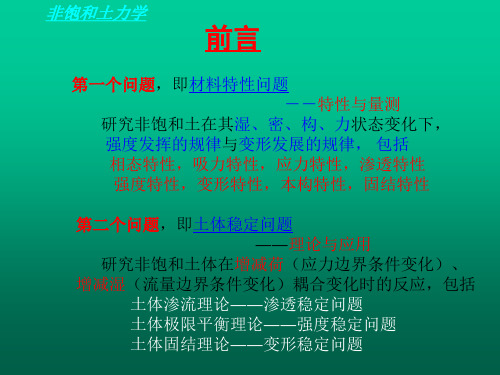
• 非饱和土基本特性的学习/2、非饱和土的吸力特性
土-水特征曲线形态的重要参数
由于土中的水分可以有 结晶水、吸着水、结合水(薄膜水)和自由水等
具有不同属性的不同类型。 含水量变化时,土中水有不同的类型,气有不同的连通,
孔隙水压力和孔隙气压力分别在土的孔隙水体 和孔隙气体中是各向等压的静水压力型应力
孔隙水压力和孔隙气压力 各自作用在其与土颗粒接触部分的表面上, 其差值对土骨架的作用不会是各处相等的。
当孔隙水为弯液面环状水时,吸力只在接触点的 法向上作用;当孔隙水为有弯液面的体积水时, 所产生的吸力必然有法向和切向两个方向上分力 的作用。国内也出现了湿吸力与牵引力的提法(汤连生)。
单一有效应力型的应力状态变量
人们在寻求非饱和土的应力状态变量时,首先想到了 单一有效应力型的应力状态变量
它不是一般的纯力学量,而是一个材料有关的力学量,与材料 的本构关系有着密切的联系(如饱和土力学中的有效应力)。 研究提出具有真实合理性的有效应力表达式是当前的主要任务。
对已经提出的各种表达式还需要作出认真的选择与检验。
导致了非饱和土十分复杂的力学性质。
• 非饱和土基本特性的学习/2、非饱和土的吸力特性
2、非饱和土的吸力特性
非饱和土的土水势一般包括 温度势、压力势、重力势、基质势和溶质势
在等温、等压、等高(不计重力)的情况下, 土中水的温度势、压力势、重力势保持不变,
自由能的变化只有基质势和溶质势的变化。
如将它们分别称之为基质吸力和溶质吸力, 它们之和,即此时的自由能,称为总吸力,则有
应该取决于各自的相对压缩性。
在孔隙流体不能排出的条件下,土受力后的孔隙水压力 和孔隙气压力的增量是一种超孔隙压力
《非饱和土有效应力》课件

非饱和土有效应力的测量方法
张力计法
利用张力计等仪器,精确测量水分 张力。
压力传感器法
安装压力传感器在试样上,得出土 方的膨胀或收缩变形数据来计算有 效应力。
蒸汽压力计法
使用蒸汽压力计测量土壤水分蒸发 时产生的压力变化,从而得知土壤 的含水量。
非饱和土有效应力与土壤力学性质的关系
1
强度特性
非饱和土具有更高的强度和压缩性。
半饱和状态
非饱和土中既有空气又有部分水 分。土体变得坚硬,不可塑。
完全非饱和
非饱和土中孔隙被空气充满。土 体表现出弹性,不可压缩。
非饱和土有效应力的定义
1 定义
非饱和土里,有效应力是抵消土颗粒重量、摩擦力以及水分张力作用而产生的应力。
2 计算公式
σ'effective = σ - u·(1 - n)
渗透特性
2
相对于饱和土,非饱和土有更低的渗透性。
3
吸水性能
非饱和土具有较高的水分吸收能力。
非饱和土有效应力的应用领域
城市建设
在城市建设中,非饱和土的特性 可用于规划公园、开挖下沉广场、 控制建筑物下降等。
农业生产
非饱和土的水分吸收能力可用于 植物生长,有益于农业生产。
地质勘探
非饱和土有效应力测量的结果, 可用于油气勘探、岩土工程、水 文地质分析等领域。
非饱和土有效应力的研究进展
微观结构研究
探索非饱和土微观结构对有效应力的影响。
多场耦合问题研究
研究非饱和土场(力、温度、水分)之间的相互作用关系。
机理计算模型研究
针对有效应力问题,发展研究新的计算模型。
结论和讨论
非饱和土的性质和有效应力的研究十分重要。进一步的研究可以促进土木工 程和农业生产领域的发展,为环境治理提供科学依据。
非饱和土的抗剪强度 土力学课 syk

理论的研究进展
非饱和土的强度是土体粒间作用力的宏观 反映,是非饱和土理论研究最主要的内容之一, 土的抗剪强度是土的一个重要力学性质,它的 准确确定对土坡和地基稳定分析及土压力计算 至关重要。 在非饱和土强度研究进程中,众多学者对 非饱和土的抗剪强度进行了大量的试验和理论 研究!提出了各自的抗剪强度公式!并逐渐考虑 了更多因素的影响
基质吸力与吸附强度
吸附强度来源于基质吸力所产生的负孔隙 水压力,负孔隙水压力在土骨架的内部产生有 效应力,因而产生这种与外力无关的强度,由 于吸附强度与外力无关,当用常规试验方法进 行试验时,吸附强度与一般粘聚力的性质相似, 所以又可称之为表观粘聚力.
土-水特征曲线
土壤水分特征曲线一般也叫做土壤特征曲线或 土壤pF曲线,它表述了土壤水势(土壤水吸力) 和土壤水分含量之间的关系。通常土壤含水量 Q以体积百分数表示,土壤吸力S以大气压表示。
非饱和土抗剪强度由有效粘聚力,净法 向应力引起的抗剪强度以及基质吸力引起的吸 附强度三个部分所组成 与饱和土的区别主要在于因基质吸力而 产生的吸附强度,抗剪强度公式的差异主要表 现在吸附强度公式的不同,进而导致抗剪强度 公式的多样化,同时也表明当前非饱和土抗剪 强度研究的广泛性和差异性.
基质吸力与吸附强度
FEDLUND的理论及修正
非饱和膨胀土
卢肇钧等(1992,1997)通过实验对非饱和膨胀 土的膨胀力与吸力及含水量、非饱和膨胀土的 膨胀力与抗剪强度的关系进行了研究,得到了 用膨胀力表示的非饱和膨胀土抗剪强度
非饱和黄土
黄土遇水产生湿陷变形,是另一类典型的 非饱和土,含水量的变化对抗剪强度有很大影 响。党进谦和李靖(1997)以陕西关中地区的马 兰黄土为对象进行了大量的实验测定和分析, 研究了非饱和黄土的抗剪强度随基质吸力变化 的特征,给出的抗剪强度公式为
非饱和土力学读书报告

非饱和土力学读书报告前言本次读书报告是关于《非饱和土力学》一书的学习总结,该书由美国伊利诺伊大学的Glenn A.Fredlund和Harianto Rahardjo以及加拿大卡尔加里大学的Murray Fredlund等人合作编写而成。
非饱和土力学是近年来土力学领域的研究热点,了解非饱和土力学的基础理论和研究方法对于相关领域的学习和研究有着极为重要的意义。
非饱和土力学概述所谓非饱和土体,其所含水分处于饱和状态和干燥状态之间,在这个过程中,土体所表现出的力学性质迥然不同。
非饱和土力学是一门研究非饱和土体力学性质的学科。
在非饱和土力学中,土体的各项力学性质(例如变形特性、渗透特性等)都与饱和的情况有着显著的差异,比如非饱和土体的渗透系数一般较小,变形特性也具有不可压缩性等特点。
非饱和土力学的研究内容非饱和土力学的研究内容主要包括以下几个方面:非饱和土体的力学特性研究非饱和土体的力学性质随着水分含量的不断变化而发生变化,因此研究非饱和土体的力学特性,了解非饱和土体的力学性质对于工程中有效地应用土体具有重要意义。
非饱和土体的渗流特性研究非饱和土体的渗流特性也是非常重要的研究方面。
非饱和土体的渗流特性直接影响着土体的稳定性,同时还影响着土壤含水量、地下水位等环境因素的变化。
非饱和土体的变形特性研究非饱和土体的变形特性是土力学领域中非常重要的研究内容。
非饱和土体的变形特性包括土体的压缩、固结、膨胀等变形特性,影响着土体的稳定性以及与其他构件相互作用的性质。
非饱和土体的渗透特性研究方法非饱和土体的渗透特性是非常重要的研究方向。
常见的非饱和土体渗透特性研究方法包括:稳态贯入试验稳态贯入试验是常用的渗透计试验。
在稳态贯入试验中,通过测量土壤内部水压随时间的变化,可以计算出土壤的稳态渗透系数。
稳态贯入试验是一种简单易行的非饱和土体渗透实验方法,可以应用于室内和场地试验。
非稳态渗透实验非稳态渗透实验是一种强大的非饱和土体渗透研究方法。
- 1、下载文档前请自行甄别文档内容的完整性,平台不提供额外的编辑、内容补充、找答案等附加服务。
- 2、"仅部分预览"的文档,不可在线预览部分如存在完整性等问题,可反馈申请退款(可完整预览的文档不适用该条件!)。
- 3、如文档侵犯您的权益,请联系客服反馈,我们会尽快为您处理(人工客服工作时间:9:00-18:30)。
•The mechanical behavior of an unsaturated soil is directly affected by changes in the pore-air and pore-water pressures. Undrained loading of an unsaturated soil generates pore pressures in both the air and water phases.•This chapter presents the pore-pressures generated as a result of the application of total stresses to the soil.•The compressibility of air, water, and air-water mixtures is presented along with the compressibility of the soil structure which is summarized in the form of a constitutive relationship.•The pore pressure response is expressed in terms of pore pressure parameters, which relate the development of pore-pressures to a change in total pressure applied to a soil mass. These parameters perform a useful role in visualizing unsaturated soil behavior.•Estimated pore pressures are required at the start of a transient consolidation type analysis.•Comparisons between the predictions and measurements of pore pressures generated by applied loads are presented and discussed.•This chapter addresses pore pressures generated under various loading conditions.Additional notes:•During undrained compression of an unsaturated soil, volume change occurs as a result of the compression of air and to a lesser extent, compression of the water. Consequently, the pore-air and pore-water pressures increase.•Soil solids can be considered to be incompressible for the stress ranges commonly encountered in engineering practice.•The compressibility of a material at a point can be defined on the volume-pressure curve during compression.•Isothermal compressibility is defined as the volume change of a fixed mass with respect to a pressure change per unit volume at a constant temperature.Additional notes:•Isothermal compressibility of air is defined as the volume change of a fixed mass of air as the pressure is changed.•The volume versus pressure relationship for air during isothermal, undrained compression can be expressed using Boyle’s law, and the final air volume, V a ,is a function of the applied absolute air pressure,•Differentiating the volume of air, V a , with respect to the absolute air pressure, defines an expression for the infinitesimal volume change of air with respect to an infinitesimal change in the absolute air pressure.•Combining this equation with Boyle’s law permits expressing the volume of air derivative with respect to the absolute air pressure.•Air compressibility can then be written as the inverse of the absolute air pressure, since the incremental change in absolute air pressure is equal to the incremental change in the gauge pressure.•The air compressibility decreases as the absolute air pressure increases.Additional notes:a u•Water compressibility can be expressed as the product of the inverse of the water volume and the water volume change with respect to a change in the water pressure.•Water compressibility measurements (Dorsey, 1940) are also a function of temperature.•Dissolved air in water produces an insignificant difference between the compressibility of water.Additional notes:•The air phase, water phase, and solid phase volumetric relations in an unsaturated soil are as shown above.•The volumetric relations are used in the formulation of the compressibility of air-water mixtures found in an unsaturated soil mass.Additional notes:•The compressibility of an air-water mixture can be derived using directproportioning of the air and water compressibilities.•The air, water and solid volumetric relations can be described in terms of the degree of saturation, S , and a porosity, n,for an unsaturated soil.•The total volume of the air-water mixture is the sum of the individual components, V a + V w . The dissolved air, V d , is within the volume of water.•The pore-air and pore-water pressures are u a and u w , with u a > u w . The soil is subjected to a compressive total stress, σ.•Applying an infinitesimal increase in total stress, d σ, to the undrained soil results in increases in both pore-air and pore-water pressures, while the volumes of air and water decreases.•The compressibility of an air-water mixture for an infinitesimal increase in total stress can be written using total stress as a reference.Additional notes:•The compressibility of an air-water mixture presented in the previous slide is slightly different from the compressibility equation proposed by Fredlund (1976) in that the pore-water pressure change, du w , was used as the reference pressure in the 1976 compressibility equation.•The term [d(V w -V d )/d σ] is considered to be equal to dVw since the dissolved air is a fixed volume internal to the water.•The total volume of water, Vw , is therefore used in computing the compressibility ofwater [ i.e., C w = -(1/V w )(dV w /du w )].•The total air volume change can be obtained directly using Boyle’s law byconsidering the initial and final pressures and the volumetric conditions with respect to the air phase.•The free and dissolved air can be considered as one volume with uniform pressure, and although the volume of dissolved air is a fixed quantity, it is carried along in the formulation.•The chain rule of differentiation can be applied to the compressibility equation.Additional notes:•The compressibility of an air-water mixture equation can be rearranged in the form shown in the first equation in order to permit the use of the volume relations, S,and the expressions previously defined for air compressibility,C a ,and water compressibility,C w , to yields the second equation shown above.•The isothermal compressibility of air, C a ,is equal to the inverse of the absolute air pressure, and therefore a third equation can be written.•The ratio between the pore pressure and the total stress change,(du/d σ), is referred to as a pore pressure parameter (Skempton, 1954; and Bishop, 1954).•The pore pressures parameters for air and water are different and depend primarily upon the degree of saturation of the soil.•The pore pressure parameters can also be experimentally measured in laboratory.•For isotropic loading conditions, the parameter is called the B pore pressure parameter.•In the absence of soil solids, the pore pressures parameters, B a and Bw , are equal to 1.0. •In the presence of soil solids, the surface tension effects and the compressibility of air, will cause the B a and B w values to be less than 1.0.Additional notes:•Several equations for the compressibility of an air-water mixture have been proposed by researchers.•The above equation is obtained by ignoring the first term of the previous equation for air-water mixture compressibility (i.e., the water compressibility term) andsetting the Ba and Bwvalues to 1.0.•The result is an equation applicable to the case where the air phase constitutes a significant portion of the fluid, and is similar to the equation proposed by Bishop and Eldin(1950).•Bishop and Eldin(1950) assumed the compressibility of air with reference to the initial volume of air, Vao, as shown in the second equation above.•Such an assumption yields a slightly different equation for the air compressibility,C a , as expressed by the third equation above which gives the average aircompressibility, (uao /ua2) during an air absolute pressure change from uaoto ua.•Replacing the air compressibility term (i.e., 1 / ua ) with the average aircompressibility term [i.e., (uao /ua2)] yields the air-water compressibility equationproposed by Bishop and Eldin(1950), expressed as the fourth equation above.•The last equation was suggested by Koning(1963) by expressing the pore-air and pore-water pressure changes as a function of surface tension. The solubility of air in water and the effect of matric suction were neglected.Additional notes:•Kelvin’s equation [i.e., (u a -u w ) = 2T s /R s ] relates matric suction to surface tension and the radius of curvature.•Attempts have been made to use Kelvin’s equation in writing an equation for the compressibility of air-water mixtures (Schuurrman, 1966; Barends, 1979).•In particular, problems arise in the case of occluded air bubbles in a soil with adegree of saturation greater than 85 %.•Kelvin’s equation results in the incorporation of the radius curvature,R s , as avariable. However, R s ,is not measurable in a soil element.•Kelvin’s equation describes a microscopic phenomenon within the soil element.The radii of the occluded air bubbles should not be incorporated into amacroscopic type formulation for compressibility.•Figure 8.6b shows a soil that is almost saturated and has its macroscopic behavior governed by effective stress. At a microscopic level, there exists numerous inter-granular stresses acting at the contacts between the soil particles in the element.•The net results of attempts to apply Kelvin’s equation, togetherHenry’s laws, to the compressibility of an air-water mixture is that an anomalyarises from a theoretical point of view. Such a formulation predicts that anincrease in matric suction occurs as the total stress is increased under undrainedloading (Fredlund and Rahardjo, 1993).Additional notes:•Experimental results indicate that the pore-air and pore-water pressures gradually increase towards a single value as the matric suction approaches zero and the total stress is increased under undrained loading. The process is gradual and in response to several increments of total stress.•The above figure illustrates the development of air and water pore pressures as well as the changes in both the shape and volume of the air bubbles within an unsaturated soil during undrained loading, as the total stress is increased.•Non-spherical air bubbles in Zone 1 could provide an explanation to justify that the decrease in free air volume is not necessarily accompanied by a decrease in the controlling radius of curvature. The assumption is made that only the controlling minimum radius is of relevance in Kelvin’s equation.•The above figure shows that although the volume of the continuous air phase in Zone 1decreases due to an increase in the pore-air pressure from ua1to ua2,the controlling radiusmay increase from Rs1to Rs2,and therefore the matric suction decreases.•Nevertheless, the increase in total stress will eventually cause the air bubbles to take on a spherical form, as shown in Zone 2.•For spherical air bubbles, a decrease in volume must be followed by a decrease in the radius. In this case, the increase of matric suction postulated by Kelvin’s equation, cannot be resolved.•It would appear that the presence of air bubbles merely renders the pore-fluid compressible. Therefore, it is recommended that the pore-air and pore-water pressures be assumed to be equal in Zone 2.Additional notes:•The pore-pressure response for a change in total stress during undrained compression has been expressed in terms of pore-pressure parameters (i.e., B a and B w ), in previous sections.•In this section , derivations are presented for pore-pressure parameters corresponding to various loading conditions.•The pore pressure parameters for the air and water phases of an unsaturated soil can be defined either as tangent-type or secant-type parameters.•These definitions are similar in concept to the tangent and secant moduli used in the theory of elasticity.•Isotropic loading is a particular case of the more general triaxial loading and is used to express the definition of the secant pore pressure parameter for the air phase.•The secant-type pore-air pressure parameter (i.e., B a ’) is defined as the ratio between the increase in pore-air pressure (i.e., response) and the increase in isotropic pressure (i.e., σ3) from the initial condition.Additional notes:•The secant-type pore-water pressure parameter (i.e., B w ’) is defined as the ratio of the increase in pore-water pressure (i.e., response) to the increase in isotropic pressure (i.e., σ3) from the initial condition.•The secant-type parameter requires the definition of initial conditions for the soil specimen in terms of both pore-pressures and applied total stress.Additional notes:•If an infinitesimal increase in the isotropic confining pressure is considered at a point along the pore-air pressure versus isotropic confining stress, σ3, relationship,the pore-air pressure response at that point can be expressed as the tangent, B a ,pore-air pressure parameter.•Similarly, a tangent pore-water pressure parameter, B w , can be defined.•The concepts of secant and tangent-type pore-air and pore-water pressure parameters are illustrated on the next slide.Additional notes:•A linear equation for total volume changes within a localized region of the constitutive surface can be written as proposed by Fredlund and Morgenstern (1976).•The compressibility parameters, m 1s and m 2s ,correspond to changes in the stress state variables, (σ-u a ) and (u a -u w ), respectively.•Total volume changes can then be predicted by using the constitutive surfaces when changes in the stress state variables are known.Additional notes:•The linear equation for pore-air volume changes can be written as proposed by Fredlund and Morgenstern (1976).•The compressibility parameters, m 1a and m 2a ,correspond to changes in the stress state variables, (σ-u a ) and (u a -u w ), respectively.•Air volume changes can be predicted using the constitutive surfaces when changes in the stress state variables are known.Additional notes:•A linear equation for pore-water volume changes can be written as proposed by Fredlund and Morgenstern (1976).•The compressibility parameters, m 1w and m 2w , correspond to changes in the stress state variables (σ-u a ) and (u a -u w ), respectively.•Water volume changes can be predicted by using the constitutive surfaces when changes in the stress state variables are known.•The continuity requirement for a referential element of an unsaturated soil can be expressed by equating total volume change to the summation of the air volume and water volume changes.•This requirement leads to the conclusion that there are two closed-formrelationships between the compressibility.Additional notes:•The application of an all-around, positive (i.e., compressive) total stress, d σ, either in drained or undrained loading, can cause a change in volume.•In drained loading, air and water are allowed to drain from the soil subsequent to the application of a total stress increment. The stress state variables in the soil are altered and the volume of the soil changes.•The volume change can be computed from the stress state variable changes in accordance with the constitutive relationship for the soil structure.•In undrained loading, the air and water are not allowed to drain from the soil. The total stress increase causes the pore-air and pore-water pressures to increase, and consequently the stress state variables also change.•The increase in the pore fluid pressures occurs in response to a compression of the pore fluid.•The volume change equivalent to the pore fluid compression, dVv , can becomputed by multiplying the compressibility of air-water mixture, C aw , by thepore fluid volume V v (i.e., V w + V a = nV ) and the total stress increment, d σ.•The volume change can also be expressed in terms of the stress state variable [i.e., (σ-u a ) and (ua -u w )] changes in accordance with the constitutive relationships for the soil structure. The equation at the bottom of the slide is the volume change due to an increase in net total stress, d(σ-u a ).Additional notes:•An increase in the total stress results in an increase in pore fluid pressures (i.e., air and water) in response to compression of the pore fluids. Therefore,there is a reduction in matric suction since the increase in pore-water pressure is greater than the increase in pore-air pressure.•The volume change due to a decrease in matric suction can be expressed by the above equation.•The total volume change can then be written as the summation of the two previous volume changes due to the changes in the stress state variables (i.e., (dVv /V o )1and (dV v /V o )2].•The last equation expresses the volume change obtained from the constitutiverelationships and can be equated to the volume change due to pore fluid compression.•The concepts involving drained and undrained volume changes are illustrated on the next slide.Additional notes:•The increase in total stress results in an increase in net normal stress and a decrease in matric suction. The stress state variable changes can be used to define the volumetric changes in the unsaturated soil mass by using the constitutive relationships.•The above figure shows the comparison between undrained loading and drained loading by using the constitutive surfaces combined with changes in stress state variables due to an increase in total stress under undrained compression.Additional notes:•In a saturated soil, the pore voids are filled with water. The pore fluidcompressibility is equal to the compressibility of water.•At saturated conditions, a total stress increase, d σ, in undrained loading is almost entirely transferred to the water phase (i.e., du w ≈d σ) and the pore-water pressure parameter approaches 1.0.•The effective stress in undrained loading remains essentially constant, and as a consequence, the volume change computed from the constitutive relationship for the soil structure is extremely small as shown in Figure 8.11a.•The soil volume change obtained from the pore fluid compression is also small because of the low compressibility of water.•In a dry soil, the pore voids are primarily filled with air which is much more compressible than the soil structure.•A total stress change during undrained loading is almost entirely transferred to the soil structure.•Figure 8.11b above illustrates a dry soil under undrained loading which also illustrates that the pore-air pressure remains constant (i.e., the B parameter is essentially zero).Additional notes:•The K o loading conditions are illustrated in the above figure where the total stress increment is applied in the vertical direction.•The total stress increment is denoted as, d σ, and the vertical direction is assumed to be the major principal stress direction.Additional notes:•The volume change equation previously presented, associated the soil volume change of the soil structure to the volume change due to the pore fluid compression (i.e., under undrained loading).•Using K o loading conditions, the pore pressure parameter equation can be expressed by the above equation where the compressibility parameters correspond to K o loading.•The last two equations extend the compressibility of the air-water mixture,C aw , by substituting the change in total stress with the soil response in terms of pore pressures. •The first term of the compressibility equation (i.e., C aw equation) refers to thecompression of the pore-water phase and the second term refers to the compression of the pore-air phase.Additional notes:•The previous volume change equation can be rearranged to yield an expression for the change in the pore-water pressure, du w , in response to a total stress change, d σ.•In the last equation, the compressibility, m 2s ,has been written as a ratio of the compressibility with respect to a total stress change, m 1k s ,which gives rise to the parameter, R sk .Additional notes:•The previous equation can be simplified by introducing the compressibility parameters, R 1k and R 2k•There are two unknowns, du w and d σy , and therefore a second independent equation is required.•The second equation is derived by considering the change in the volume of air. •The change in volume is described by the constitutive relationship for the air phase which is equated to the volume change of air due to the compressibility of the air term multiplied by pore fluid volume (i.e., nV).•In this equation, the compressibility parameter, m 1k a ,is introduced.•In a similar procedure to that used for the soil structure, the last equation introduces the parameter R ak , that is defined as the ratio between the air phase compressibility, m2a ,and the air phase compressibility with respect to a total stress change, m 1k a .Additional notes:•The previous equation can be rewritten to give the change in pore-air pressure, du a , due to a total stress increment, d σy .•The expression can be simplified by introducing the ratio parameters, R 3k , and R 4k , as illustrated above.Additional notes:•The pore-air and pore-water parameters for Ko undrained loading can be written as B ak and B w k parameters, respectively. These pore-pressure parameters are defined as tangent-type parameters referenced to a particular stress point.•The expressions for du a and du w are from the previous equations where the pore-air and pore-water responses, at any stress point during Ko undrained loading, are a directfunction of the B ak and B w k pore pressure parameters.Additional notes:•Hilf (1948) outlined a procedure to compute the change in pore pressure in compacted earth fills as a result of an applied total stress. This method has been extensively used by the United States Bureau of Reclamation (i.e., U.S.B.R.), and has proven to be to be quite satisfactory in engineering practice (Gibbs et al, 1960).•The derivation is based on the results of a one-dimensional oedometer test on acompacted soil, Boyle’s law, and Henry’s law. A relationship between total stress and pore-water pressure is derived.•Hilf (1948) stated: “... consider a sample of moist earth compacted in a laboratory cylinder, as illustrated before. If a static load is applied by means of a tight-fitting piston , permitting neither air nor water to escape, it is found that there is a measurable reduction in volume of the soil mass”.•The reduction in volume was assumed to be the result of compression of free air and free air dissolving into water. Free and dissolved air are considered as a single phase.•The initial and final conditions considered in Hilf’s analysis are shown in the next slide. The total volume of air associated with the initial condition, Vao , can be writtenas shown above, with the first and second terms representing thefree and dissolved air volumes.•The air volume change can be written as a change in porosity, ∆n , times the initial volume of soil, V o ,. Therefore, the total volume of air under final conditions, V af , can be expressed by the above equation. •The final absolute air pressure is shown in the last equation.Additional notes:•Boyle’s law can be applied to the initial and final conditions of the free and dissolved air.•By substituting the initial and final air volumes into the above equation, andrearranging, it yields an expression for the change in the pore-air pressure as a function of the initial pore-air pressure.•The above equation for the change in absolute pore-air pressure is commonly referred to as Hilf’s equation, which provides a relationship between the change in pore-air pressure and the change in pore-air volume (i.e., ∆n ).•In order to reach saturation, the soil volume change, ∆Vv , must equal the volume offree air (i.e., (1-S o ) n o V o ). The change in porosity corresponding to this condition is expressed above (i.e., ∆n ).•Substituting the equation for a change in porosity, ∆n,into the equation for thechange in pore-air pressure, gives the absolute pore-air pressure change (i.e., increase) required to saturate a soil.Additional notes:•The previous equation for pore-air pressure change can be written in an alternate way form by replacing the change in porosity, ∆n,with (∆V v /V o ), which expresses the volume change due to the compression of air.•Assuming that the change in matric suction is negligible, the total volume change can also be obtained from the constitutive surfaces relationship [i.e., as a function of ∆(σv -u a )].•Near saturation, the soil compressibility parameter, m 1s ,can be assumed to be equal to the coefficient, m v ,measured under saturated conditions.Additional notes:•The pore-pressure parameter for K o undrained loading can be derived using Hilf’s analysis by equating the volume change of the soil structure to the volume change due to the compression of air.•The second equation in this slide shows the expression for the change in pore-air pressure, which is obtained by rearranging the first equation shown.•The secant pore pressure parameter, B áh , derived from Hilf’s analysis is thenexpressed as the third equation on the above slide.Additional notes:•For an isotropic soil under three-dimensional loading, the constitutive relationship for the soil structure is expressed by the above equation.•In the case of isotropic loading, the total stress increments are equal in all directions.Therefore, the constitutive relationship for an isotropic soil under isotropic loading can be written as the second equation.•The compressibility of the air-water mixture, C aw , is obtained from the previously shown equations by using the isotropic pressure increment, d σ3, for the total stress increment, d σ.•Volume change due to the pore fluid compression, dVv , is computed from thecompressibility, C aw equation multiplied by the pore fluid volume, V v (i.e., nV ), and the isotropic pressure increment, d σ3.Additional notes:•The change in volume of the soil structure must be equal to the change in volume due to pore fluid compression, as expressed by the first equation on this slide.•That equation can be rearranged to express the change in pore-water pressure, du w , as a function of the change in pore-air pressure and the change in total confining stress.•Another equation can be derived by considering the continuity of the air phase. The constitutive relationship for the air phase of an isotropic soil under three-dimensional loading can be written as the third equation above.•For isotropic loading, the constitutive relationship for the air phase of an isotropic soil is obtained by substituting the condition of ( d σ1 = d σ2 = d σ3). The result is the fourth equation.•Volume change due to the compression of air, dV a , is also represented by the fifth equation which is the second term of the pore fluid compression equation , dV v .•The last equation is obtained by equating the volume change due to thecompression of air to the volume change predicted by the constitutive relationship.Additional notes:•Solving the previous equation for the change in pore-air pressure, du a , results the first equation given above.•The compressibility of the soil structure, m 2s ,can be expressed as a ratio of m 1s , as shown by the R s parameter.•The expression for the pore-water pressure change can then be written as shown by the third equation, and simplified, by using the R 1and R 2parameters.Additional notes:•Solving the previous equation for the change in pore-air pressure, du a , results in the first equation given above.•In a similar manner, the compressibility, m 2a , can be related to the m1acompressibility coefficient by the ratio R a,as shown in the first equation.•The expression for the pore-air pressure change can then be written in the form presented in the second equation, and simplified by using the R 3and R 4parameters to give the form presented in the third equation on the slide.•Therefore, the pore pressure parameters B a (i.e., du a /ds 3) and B w (i.e., du a /ds 3) can be expressed as shown above.Additional notes:。
